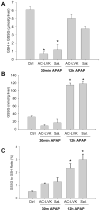Lysosomal instability and cathepsin B release during acetaminophen hepatotoxicity
- PMID: 22900545
- PMCID: PMC3501614
- DOI: 10.1111/j.1742-7843.2012.00931.x
Lysosomal instability and cathepsin B release during acetaminophen hepatotoxicity
Abstract
Acetaminophen (APAP) overdose is currently the most frequent cause of drug-induced liver failure in the United States. Recently, it was shown that lysosomal iron translocates to mitochondria where it contributes to the collapse of the mitochondrial membrane potential. Therefore, the purpose of this study was to investigate whether cathepsin B, a lysosomal protease, is involved in APAP-induced hepatotoxicity. Cathepsin B activity was measured in subcellular liver fractions of C57Bl/6 mice 3 hr after 300 mg/kg APAP treatment. There was a significant increase in cytoplasmic cathepsin activity, concurrent with a decrease in microsomal activity, indicative of lysosomal cathepsin B release. To investigate the effect of cathepsin B on hepatotoxicity, the cathepsin inhibitor AC-LVK-CHO was given 1 hr prior to 300 mg/kg APAP treatment along with vehicle control. There was no difference between groups in serum alanine aminotransferase (ALT) values, or by histological evaluation of necrosis, although cathepsin B activity was inhibited by 70-80% compared with controls. These findings were confirmed with a different inhibitor (z-FA-fmk) in vivo and in vitro. Hepatocytes were exposed to 5 mM acetaminophen. Lysotracker staining confirmed lysosomal instability and cathepsin B release, but there was no reduction in cell death after treatment with cathepsin B inhibitors. Finally, cathepsin B release was measured in clinical samples from patients with APAP-induced liver injury. Low levels of cathepsin B were released into plasma from overdose patients. APAP overdose causes lysosomal instability and release of cathepsin B into the cytosol but does not contribute to liver injury under these conditions.
© 2012 The Authors Basic & Clinical Pharmacology & Toxicology © 2012 Nordic Pharmacological Society.
Figures






Similar articles
-
Suppression of iron mobilization from lysosomes to mitochondria attenuates liver injury after acetaminophen overdose in vivo in mice: Protection by minocycline.Toxicol Appl Pharmacol. 2020 Apr 1;392:114930. doi: 10.1016/j.taap.2020.114930. Epub 2020 Feb 25. Toxicol Appl Pharmacol. 2020. PMID: 32109512 Free PMC article.
-
Editor's Highlight: Metformin Protects Against Acetaminophen Hepatotoxicity by Attenuation of Mitochondrial Oxidant Stress and Dysfunction.Toxicol Sci. 2016 Dec;154(2):214-226. doi: 10.1093/toxsci/kfw158. Epub 2016 Aug 25. Toxicol Sci. 2016. PMID: 27562556 Free PMC article.
-
Apoptosis-inducing factor modulates mitochondrial oxidant stress in acetaminophen hepatotoxicity.Toxicol Sci. 2011 Aug;122(2):598-605. doi: 10.1093/toxsci/kfr116. Epub 2011 May 13. Toxicol Sci. 2011. PMID: 21572097 Free PMC article.
-
4-Methylpyrazole protects against acetaminophen hepatotoxicity in mice and in primary human hepatocytes.Hum Exp Toxicol. 2018 Dec;37(12):1310-1322. doi: 10.1177/0960327118774902. Epub 2018 May 9. Hum Exp Toxicol. 2018. PMID: 29739258 Free PMC article.
-
Acetaminophen: Dose-Dependent Drug Hepatotoxicity and Acute Liver Failure in Patients.Dig Dis. 2015;33(4):464-71. doi: 10.1159/000374090. Epub 2015 Jul 6. Dig Dis. 2015. PMID: 26159260 Free PMC article. Review.
Cited by
-
Central Mechanisms of Acetaminophen Hepatotoxicity: Mitochondrial Dysfunction by Protein Adducts and Oxidant Stress.Drug Metab Dispos. 2024 Jul 16;52(8):712-721. doi: 10.1124/dmd.123.001279. Drug Metab Dispos. 2024. PMID: 37567742 Free PMC article. Review.
-
Lysosomal Cholesterol Accumulation Sensitizes To Acetaminophen Hepatotoxicity by Impairing Mitophagy.Sci Rep. 2015 Dec 11;5:18017. doi: 10.1038/srep18017. Sci Rep. 2015. PMID: 26657973 Free PMC article.
-
Ferroptosis and Acetaminophen Hepatotoxicity: Are We Going Down Another Rabbit Hole?Gene Expr. 2021 Jun 11;20(3):169-178. doi: 10.3727/105221621X16104581979144. Epub 2021 Jan 13. Gene Expr. 2021. PMID: 33441220 Free PMC article. Review.
-
Argininosuccinate synthetase as a plasma biomarker of liver injury after acetaminophen overdose in rodents and humans.Biomarkers. 2014 May;19(3):222-30. doi: 10.3109/1354750X.2014.897757. Epub 2014 Mar 6. Biomarkers. 2014. PMID: 24597531 Free PMC article.
-
Mitochondrial-Lysosomal Axis in Acetaminophen Hepatotoxicity.Front Pharmacol. 2018 May 15;9:453. doi: 10.3389/fphar.2018.00453. eCollection 2018. Front Pharmacol. 2018. PMID: 29867464 Free PMC article. Review.
References
-
- Mitchell JR, Jollow DJ, Potter WZ, Gillette JR, Brodie BB. Acetaminophen-induced hepatic necrosis. IV. Protective role of glutathione. J Pharmacol Exp Ther. 1973;187:211–7. - PubMed
-
- Larson AM, Polson J, Fontana RJ, Davern TJ, Lalani E, Hynan LS, et al. Acetaminophen-induced acute liver failure: results of a United States multicenter, prospective study. Hepatology. 2005;42:1364–72. - PubMed
-
- Hinson JA, Reid AB, McCullough SS, James LP. Acetaminophen- induced hepatotoxicity: role of metabolic activation, reactive oxygen nitrogen species, and mitochondrial permeability transition. Drug Metab Rev. 2004;36:805–22. - PubMed
-
- Cohen SD, Pumford NR, Khairallah EA, Boekelheide K, Pohl LR, Amouzadeh HR, et al. Selective protein covalent binding and target organ toxicity. Toxicol Appl Pharmacol. 1997;143:1–12. - PubMed
-
- Tirmenstein MA, Nelson SD. Subcellular binding and effects on calcium homeostasis produced by acetaminophen and a nonhepatotoxic regioisomer, 3′-hydroxyacetanilide, in mouse liver. J Biol Chem. 1989;264:9814–9. - PubMed
Publication types
MeSH terms
Substances
Grants and funding
LinkOut - more resources
Full Text Sources
Medical

